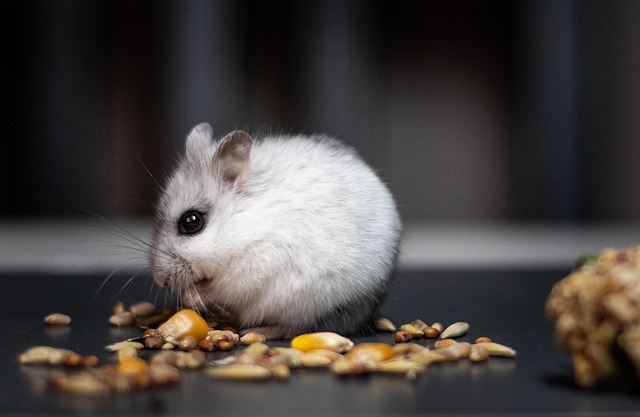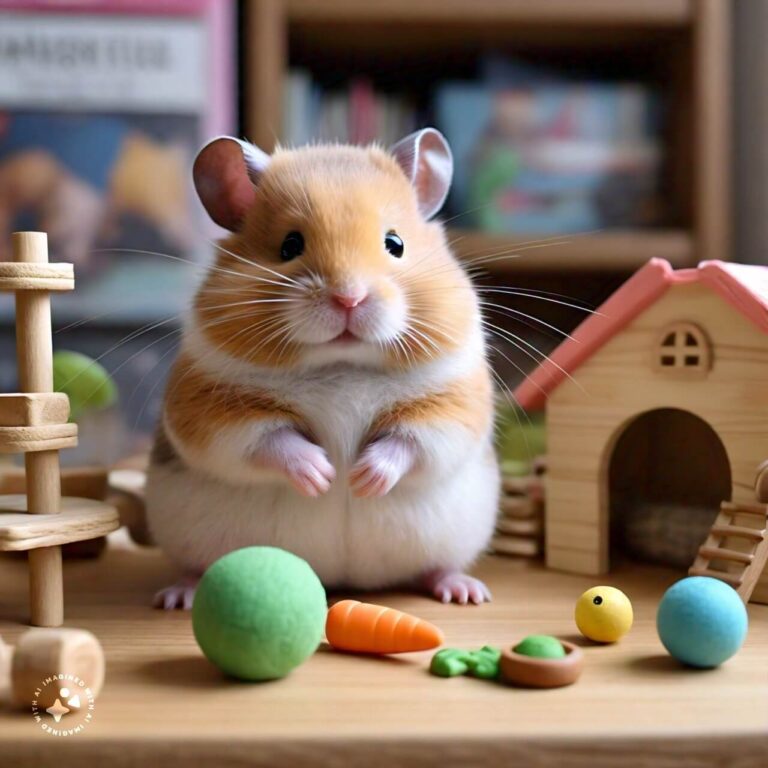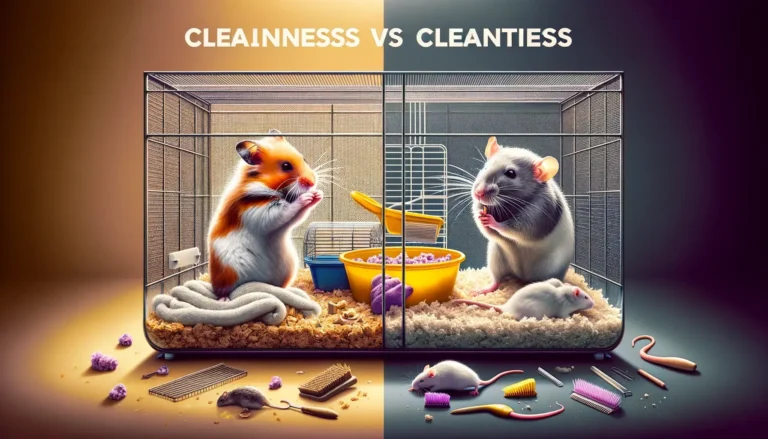Are Hamsters Better Than Rats – Hamsters.pk
Exploring the Health and Lifespan Differences Between Hamsters and Rats
When considering a small pet, many people find themselves comparing hamsters and rats. While both animals can make excellent companions, they have distinct health needs and lifespans that potential owners should be aware of. In this article, we’ll delve into the key differences between hamsters and rats in terms of their health and longevity.
Hamster Health and Lifespan
Hamsters are generally hardy animals, but they are prone to certain health issues. One common problem is dental malocclusion, which occurs when their continuously growing teeth become misaligned or overgrown. Regular tooth trimming may be necessary to prevent this issue from causing pain or difficulty eating.
Hamsters are also susceptible to respiratory infections, especially if their cage is not kept clean or if they are exposed to drafts or extreme temperature changes. Symptoms may include sneezing, wheezing, and discharge from the eyes or nose.
The average lifespan of a hamster is 2-2.5 years, although some individuals may live up to 3 years with proper care. Factors that can influence a hamster’s lifespan include genetics, diet, exercise, and overall health.
Rat Health and Lifespan
Rats are generally healthy animals, but they are prone to certain health issues as well. One common problem is respiratory disease, which can be caused by a variety of factors including genetics, poor ventilation, and exposure to irritants such as ammonia from urine.
Rats are also susceptible to tumors, particularly mammary tumors in females. Regular check-ups with a veterinarian can help detect and treat these issues early on.
The average lifespan of a rat is 2-3 years, although some individuals may live up to 4 years with proper care. Factors that can influence a rat’s lifespan include genetics, diet, exercise, and overall health.
Comparing Health Needs
While both hamsters and rats require regular veterinary check-ups and a balanced diet, there are some key differences in their health needs:
- Dental care: Hamsters require regular tooth trimming to prevent dental issues, while rats do not have this specific need.
- Respiratory health: Both animals are prone to respiratory issues, but rats may be more susceptible due to their larger size and more complex respiratory system.
- Exercise: Rats require more space and opportunities for exercise than hamsters, as they are more active and playful.
- Diet: While both animals require a balanced diet, rats have more specific nutritional needs and may require a higher protein diet than hamsters.
Conclusion
When deciding between a hamster and a rat, it’s important to consider their distinct health needs and lifespans. While both animals can make wonderful pets, they require different levels of care and attention to maintain their health and well-being.
If you’re looking for a pet with a slightly longer lifespan and more complex health needs, a rat may be the right choice for you. However, if you prefer a smaller, hardier pet with simpler care requirements, a hamster may be a better fit.
Ultimately, the key to a happy and healthy pet is providing them with a balanced diet, regular veterinary care, and plenty of love and attention throughout their lives.

Exploring the Health and Lifespan Differences Between Hamsters and Rats
When considering a small pet, many people find themselves comparing hamsters and rats. While both animals can make excellent companions, they have distinct health needs and lifespans that potential owners should be aware of. In this article, we’ll delve into the key differences between hamsters and rats in terms of their health and longevity.
Hamster Health and Lifespan
Hamsters are generally hardy animals, but they are prone to certain health issues. One common problem is dental malocclusion, which occurs when their continuously growing teeth become misaligned or overgrown. Regular tooth trimming may be necessary to prevent this issue from causing pain or difficulty eating.
Hamsters are also susceptible to respiratory infections, especially if their cage is not kept clean or if they are exposed to drafts or extreme temperature changes. Symptoms may include sneezing, wheezing, and discharge from the eyes or nose.
The average lifespan of a hamster is 2-2.5 years, although some individuals may live up to 3 years with proper care. Factors that can influence a hamster’s lifespan include genetics, diet, exercise, and overall health.
Rat Health and Lifespan
Rats are generally healthy animals, but they are prone to certain health issues as well. One common problem is respiratory disease, which can be caused by a variety of factors including genetics, poor ventilation, and exposure to irritants such as ammonia from urine.
Rats are also susceptible to tumors, particularly mammary tumors in females. Regular check-ups with a veterinarian can help detect and treat these issues early on.
The average lifespan of a rat is 2-3 years, although some individuals may live up to 4 years with proper care. Factors that can influence a rat’s lifespan include genetics, diet, exercise, and overall health.
Comparing Health Needs
While both hamsters and rats require regular veterinary check-ups and a balanced diet, there are some key differences in their health needs:
- Dental care: Hamsters require regular tooth trimming to prevent dental issues, while rats do not have this specific need.
- Respiratory health: Both animals are prone to respiratory issues, but rats may be more susceptible due to their larger size and more complex respiratory system.
- Exercise: Rats require more space and opportunities for exercise than hamsters, as they are more active and playful.
- Diet: While both animals require a balanced diet, rats have more specific nutritional needs and may require a higher protein diet than hamsters.
Conclusion
When deciding between a hamster and a rat, it’s important to consider their distinct health needs and lifespans. While both animals can make wonderful pets, they require different levels of care and attention to maintain their health and well-being.
If you’re looking for a pet with a slightly longer lifespan and more complex health needs, a rat may be the right choice for you. However, if you prefer a smaller, hardier pet with simpler care requirements, a hamster may be a better fit.
Ultimately, the key to a happy and healthy pet is providing them with a balanced diet, regular veterinary care, and plenty of love and attention throughout their lives.
Examining the Housing and Care Requirements for Hamsters and Rats
When bringing home a new pet, whether it’s a hamster or a rat, it’s crucial to understand their specific housing and care requirements. While both animals are small rodents, they have distinct needs that must be met to ensure their health, happiness, and well-being. In this article, we’ll explore the key differences between hamsters and rats in terms of their housing and care.
Housing Requirements for Hamsters
Hamsters are solitary animals that require a minimum of 450 square inches of floor space in their cage. They also need a cage with a solid bottom and plenty of bedding for burrowing, as this is a natural behavior for them. Wire cages with platforms are popular choices, as they provide ample space for exercise and exploration.
Hamsters also require a variety of accessories in their cage, including:
- A wheel for exercise
- Hiding spots such as tunnels or hideouts
- Chew toys to keep their teeth trimmed
- A food dish and water bottle
It’s essential to keep a hamster’s cage clean and tidy, with regular spot-cleaning and a thorough cleaning every 1-2 weeks.
Housing Requirements for Rats
Rats are social animals that require a larger cage than hamsters, with a minimum of 2 cubic feet of space per rat. They also need a cage with multiple levels and plenty of accessories for climbing and exploration, such as ramps, platforms, and hammocks.
Like hamsters, rats also require a variety of accessories in their cage, including:
- Hiding spots such as boxes or tunnels
- Chew toys to keep their teeth trimmed
- A food dish and water bottle
- Litter box for waste
Rats produce more waste than hamsters, so their cages require more frequent cleaning. Spot-cleaning should be done daily, with a thorough cleaning every 1-2 weeks.
Care Requirements for Hamsters and Rats
In addition to proper housing, both hamsters and rats require specific care to maintain their health and well-being. This includes:
- A balanced diet consisting of commercial pellets, fresh fruits and vegetables, and occasional treats
- Fresh water available at all times
- Regular handling and socialization to keep them tame and friendly
- Veterinary check-ups to monitor their health and address any issues
However, there are some key differences in their care requirements:
- Exercise: Rats require more exercise than hamsters and should be given plenty of time outside their cage to play and explore.
- Grooming: Rats are fastidious groomers and don’t require regular baths, while hamsters may need occasional dust baths to keep their coat clean.
- Socialization: Rats are highly social and should be kept in pairs or groups, while hamsters are solitary and should be housed alone.
Conclusion
When deciding between a hamster and a rat, it’s important to consider their distinct housing and care requirements. While both animals can make wonderful pets, they have specific needs that must be met to ensure their health and happiness.
If you have limited space and prefer a solitary pet, a hamster may be the right choice for you. However, if you have more space and want a social, interactive pet, a rat may be a better fit.
Regardless of which pet you choose, providing them with proper housing, a balanced diet, regular veterinary care, and plenty of love and attention will help them thrive and bring joy to your life for years to come.
Evaluating the Cost and Availability of Hamsters and Rats as Pets
When considering a new pet, it’s essential to evaluate the cost and availability of the animal to ensure that it fits within your budget and lifestyle. Hamsters and rats are both popular small pets, but they have different price points and availability depending on various factors. In this article, we’ll explore the key considerations when evaluating the cost and availability of hamsters and rats as pets.
Cost of Purchasing Hamsters and Rats
The initial cost of purchasing a hamster or rat can vary depending on several factors, including:
- Breed: Some breeds of hamsters and rats are rarer or more popular than others, which can affect their price.
- Age: Baby hamsters and rats may be more expensive than adults, as they are in higher demand.
- Source: Purchasing from a reputable breeder or pet store may be more expensive than adopting from a rescue or shelter.
On average, the cost of purchasing a hamster ranges from $5 to $20, while the cost of purchasing a rat ranges from $10 to $20.
Cost of Housing and Accessories
In addition to the initial purchase price, it’s important to consider the cost of housing and accessories for your new pet. This includes:
- Cage: Hamsters require a minimum of 450 square inches of floor space, while rats require a minimum of 2 cubic feet per rat. Cages can range from $30 to $100 or more depending on size and features.
- Bedding: Both hamsters and rats require bedding for their cage, which can cost $5 to $20 per month depending on the type and amount used.
- Accessories: Hamsters and rats require a variety of accessories in their cage, such as a wheel, hiding spots, chew toys, and food and water dishes. These can cost an additional $20 to $50 upfront.
Cost of Food and Veterinary Care
Ongoing costs for hamsters and rats include food and veterinary care. A balanced diet consisting of commercial pellets, fresh fruits and vegetables, and occasional treats can cost $10 to $20 per month.
Veterinary care is also an important consideration, as both hamsters and rats require regular check-ups and may need treatment for health issues. The cost of veterinary care can vary depending on the issue and location, but it’s important to budget for $50 to $100 per year for routine care.
Availability of Hamsters and Rats
The availability of hamsters and rats can vary depending on your location and the time of year. Some factors to consider include:
- Pet stores: Many pet stores carry hamsters and rats year-round, but the selection may be limited to popular breeds.
- Breeders: Reputable breeders may have a wider selection of breeds available, but they may be more difficult to find and may have waiting lists.
- Rescues and shelters: Adopting from a rescue or shelter can be a great option, as there are often many hamsters and rats in need of homes. However, the availability may vary depending on the time of year and location.
Conclusion

When evaluating the cost and availability of hamsters and rats as pets, it’s important to consider not only the initial purchase price but also the ongoing costs of housing, accessories, food, and veterinary care.
While hamsters may be slightly less expensive upfront, rats may be more readily available and have a longer lifespan, which can make them a better long-term investment.
Ultimately, the decision between a hamster and a rat should be based on your personal preferences, lifestyle, and budget. By doing your research and carefully considering the costs and availability of each pet, you can make an informed decision and provide your new companion with the best possible care.











